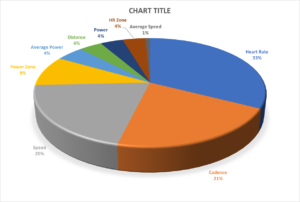An axiom or “truth” if you like that I learnt from nearly 40 years in corporate life is that you cannot manage what you cannot measure. Although this comes from business, it is equally true for all types of training, and with the price of cycling computers and sensors plummeting in recent years, it is now possible to record your training sessions without breaking the bank.
However, the benefits of cycling computers (beyond being used for navigation) are only realised once you begin to train to improve fitness or to prepare for a particular event such as a charity ride, or sportive that you foolishly signed up to with your friends without knowing what you were letting yourself in for ![]() 🙂
🙂
I recently did a survey with a friendly group of 130 cyclists to try to understand what they measure when cycling. As you can see from the photo, by far the most common thing was heart rate (33%) , followed by cadence (21%) and speed (20%). 
Let’s look at these in a little more detail.
Heart Rate
I have previously talked about training in your own personal “sweetspot”, ie sufficinet hard enough to make a difference, but not too strenous where you are likely to cause yourself an injury. Once you know where your sweetspot is, it is therefore possible to devise a plan such that you ride according to your particular heart rate “zones”. In essence, using your heart rate ensures you get the best session possible for you – if you’re going to sweat, make it worthwhile !
Cadence
I have also talked about the importance of maintaining a good pedalling speed (cadence) such that you are creating the right balance between spinning (giving you a cardiovascular workout) and grinding (a muscular workout), so by having a cadence meter you are able to monitor the speed at which you are pedaling and recognise if you are pedalling too fast..or more likely that you are slowing down as you tire, and therefore in both instances need to use the gears more effectively to correct the cadence back up to your optimum. Cadence can therefore help prevent stress injuries and keep you in the optimum pedalling zone.
Speed
Another benefit of a cycling computer is recording how fast you have been riding. While knowing how fast you are going at the time is particularly attractive if you are slightly competitive, seeing your average speed increasing from say 10mph to 18mph as you get fitter, is very rewarding and allows you to gauge how you compare with other riders. For example if you wanted to ride in a group or club, they usually say what the ride’s average speed will be, so you can choose which group to ride in, comfortable in the knowledge that you can keep up and hence have a much more enjoyable time than if you were battling at the back of the group.
So, if you are struggling to justify getting a computer, I hope the above gives you additional insights to the benefits. If you have recently bought a cycling computer but don’t know how it can help you beyond navigation, I hope this gives you a little more confidence to start to use it more effectively. Either way, feel free to contact me (www.cycleforfitness.com) if you need a little more advice.
In the next blog I will talk about the trials and tribulations of geting cycling computers and sensors talking to each other. Until then, safe riding.
cheers, Grant@cycleforfitness.com
